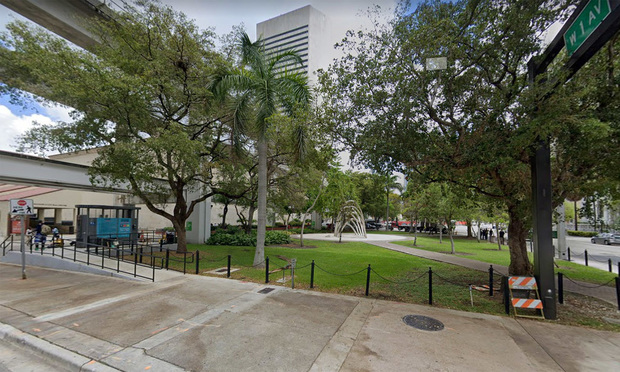Arsenic, Lead, Other Pollutants Found at New Miami Civil Courthouse Site
The pollutants, which are present above accepted levels, won't deter the new courthouse but could push costs up and push back completion.
August 12, 2019 at 03:28 PM
5 minute read
 100 W Flagler St., Miami. Photo: Google
100 W Flagler St., Miami. Photo: Google
The downtown Miami site picked for a new courthouse has arsenic, lead and other pollutants, according to a memo by Miami-Dade County. The courthouse can still be built there, but whether the necessary cleanup would push back completion and how much costs would be affected aren’t clear, the county said.
Miami-Dade County is developing a new civil and probate courthouse on a vacant half acre it owns along Flagler Street between the existing courthouse and the Metromover tracks. The new facility is needed because the existing one, built 91 years ago at 73 W. Flagler St., has termites, mold, and water and plumbing leaks.
The new site’s soil has contaminants present in quantities above what scientists have deemed as acceptable and harmless, according to the July 1 memo. Arsenic also is present in the groundwater.
“Generally speaking there’s a certain level permitted to exist within the soil and groundwater where it’s not deemed to be a hazard or unsafe to build on,” said Dan Chatlos, Miami-Dade Internal Services Department strategic program director. “The groundwater and soil samples that were gathered at the project site exceeded what’s permitted.”
The property will have to be cleaned up before construction starts, Chatlos said.
The other metals present above accepted levels are cadmium, chromium and lead. There also are polynuclear aromatic hydrocarbons, including benzo(a)anthracene and benzo(a)pyrene, according to the environmental report.
Some of these could be harmful, including to people’s nervous and respiratory systems, and some are carcinogens. Benzo(a)anthracene is a carcinogen that also is in tobacco smoke.
The finding comes as the county is selecting a developer for the public-private project in which the developer would front the cost and build the facility, and the county would pay back over time.
The county last year projected $1.2 billion in payments over 30 years, but this likely didn’t include any environmental cleanup costs, Chatlos said.
If there is a cleanup cost, then the developer would cover it and then the county would pay back the developer through its annual installments.
Beyond the payments to the developer, the county already is paying because of the contamination. It had to shell out nearly $15,900 for follow-up testing recommended by the environmental consultant, Chatlos said.
Once the additional testing is done, the county will have a better idea how much money, if any at all, it would end up paying for cleanup, Chatlos said.
The exact cause of the pollution is unknown, although the report points out the land used to be a railroad right of way.
Railroad mogul Henry Flagler significantly grew Florida’s railway system in the late 1800s and early 1900s, including expanding into downtown Miami.
“It’s typical for sites that were rights of way for railroads to have issues with arsenic and other sorts of contamination. Historically that’s been the case,” Chatlos said.
If there is a cleanup cost the county didn’t foresee, then it would be the second increase in the annual installments the county would end up paying the developer.
Last year, the county determined that it would pay $38.7 million for the first year it occupies the courthouse, 49% more than the $26 million previously announced due to rising interest rates, rising construction costs and building at this site.
Mayor Carlos Gimenez had pushed for a different county-owned site north of the Flagler spot, but commissioners overrode him after the legal community overwhelmingly said it wanted to stay close to Flagler.
The Flagler location is smaller, requiring a taller, more expensive building, as well as an $800,000 annual rent from the county to satisfy the conditions of a grant it used to buy the site. The county used a Federal Transit Administration grant in 1979, and it must pay market rent if it chooses to use the land for nontransit uses.
Construction is to start in July 2020, although the county is moving ahead of schedule. It expects to select a developer in November, five months sooner than expected, Chatlos said.
Five development teams applied and the county narrowed down the list to three. They are M-S-E Judicial Partners LLC, a partnership of the DLR Group and Suffolk Construction; Plenary Group USA Concessions Ltd., whose partners include design and architectural firm HOK and Los Angeles-based Tutor Perini Corp.; and Sacyr Infrastructure USA, a partnership of Sacyr SA, AECOM and Plaza Construction.
The team of Coral Gables-based Florida East Coast Industries LLC and El Paso, Texas-based Hunt Cos. Inc., originally an alternate in case the three top-ranked teams failed to submit plans, is now out as all three turned in proposals.
FECI is the parent company of the Virgins Trains USA passenger train that connects the downtowns of Miami, Fort Lauderdale and West Palm Beach.
Related stories:
List of Possible Miami-Dade Civil Courthouse Builders Narrows to 3
First-Year Courthouse Price Tag Jumps 49 Percent in Miami-Dade After Location Change
New Miami Civil Courthouse Site Selected With Construction Set for 2020
Brightline Miami-Dade Courthouse Plan Stays in the Running, Along With Four Others
This content has been archived. It is available through our partners, LexisNexis® and Bloomberg Law.
To view this content, please continue to their sites.
Not a Lexis Subscriber?
Subscribe Now
Not a Bloomberg Law Subscriber?
Subscribe Now
NOT FOR REPRINT
© 2025 ALM Global, LLC, All Rights Reserved. Request academic re-use from www.copyright.com. All other uses, submit a request to [email protected]. For more information visit Asset & Logo Licensing.
You Might Like
View All
Fowler White Burnett Opens Jacksonville Office Focused on Transportation Practice
3 minute read
How Much Coverage Do You Really Have? Valuation and Loss Settlement Provisions in Commercial Property Policies
10 minute read
The Importance of 'Speaking Up' Regarding Lease Renewal Deadlines for Commercial Tenants and Landlords
6 minute read
Meet the Attorneys—and Little Known Law—Behind $20M Miami Dispute
Trending Stories
- 1Plaintiff Argues Jury's $22M Punitive Damages Finding Undermines J&J's Talc Trial Win
- 2Bannon's Fraud Trial Delayed One Week as New, 'More Aggressive,' Defense Attorneys Get Ready
- 3'AI-Generated' Case References? This African Law Firm Is Under Investigation
- 4John Deere Annual Meeting Offers Peek Into DEI Strife That Looms for Companies Nationwide
- 5Why Associates in This Growing Legal Market Are Leaving Their Firms
Who Got The Work
J. Brugh Lower of Gibbons has entered an appearance for industrial equipment supplier Devco Corporation in a pending trademark infringement lawsuit. The suit, accusing the defendant of selling knock-off Graco products, was filed Dec. 18 in New Jersey District Court by Rivkin Radler on behalf of Graco Inc. and Graco Minnesota. The case, assigned to U.S. District Judge Zahid N. Quraishi, is 3:24-cv-11294, Graco Inc. et al v. Devco Corporation.
Who Got The Work
Rebecca Maller-Stein and Kent A. Yalowitz of Arnold & Porter Kaye Scholer have entered their appearances for Hanaco Venture Capital and its executives, Lior Prosor and David Frankel, in a pending securities lawsuit. The action, filed on Dec. 24 in New York Southern District Court by Zell, Aron & Co. on behalf of Goldeneye Advisors, accuses the defendants of negligently and fraudulently managing the plaintiff's $1 million investment. The case, assigned to U.S. District Judge Vernon S. Broderick, is 1:24-cv-09918, Goldeneye Advisors, LLC v. Hanaco Venture Capital, Ltd. et al.
Who Got The Work
Attorneys from A&O Shearman has stepped in as defense counsel for Toronto-Dominion Bank and other defendants in a pending securities class action. The suit, filed Dec. 11 in New York Southern District Court by Bleichmar Fonti & Auld, accuses the defendants of concealing the bank's 'pervasive' deficiencies in regards to its compliance with the Bank Secrecy Act and the quality of its anti-money laundering controls. The case, assigned to U.S. District Judge Arun Subramanian, is 1:24-cv-09445, Gonzalez v. The Toronto-Dominion Bank et al.
Who Got The Work
Crown Castle International, a Pennsylvania company providing shared communications infrastructure, has turned to Luke D. Wolf of Gordon Rees Scully Mansukhani to fend off a pending breach-of-contract lawsuit. The court action, filed Nov. 25 in Michigan Eastern District Court by Hooper Hathaway PC on behalf of The Town Residences LLC, accuses Crown Castle of failing to transfer approximately $30,000 in utility payments from T-Mobile in breach of a roof-top lease and assignment agreement. The case, assigned to U.S. District Judge Susan K. Declercq, is 2:24-cv-13131, The Town Residences LLC v. T-Mobile US, Inc. et al.
Who Got The Work
Wilfred P. Coronato and Daniel M. Schwartz of McCarter & English have stepped in as defense counsel to Electrolux Home Products Inc. in a pending product liability lawsuit. The court action, filed Nov. 26 in New York Eastern District Court by Poulos Lopiccolo PC and Nagel Rice LLP on behalf of David Stern, alleges that the defendant's refrigerators’ drawers and shelving repeatedly break and fall apart within months after purchase. The case, assigned to U.S. District Judge Joan M. Azrack, is 2:24-cv-08204, Stern v. Electrolux Home Products, Inc.
Featured Firms
Law Offices of Gary Martin Hays & Associates, P.C.
(470) 294-1674
Law Offices of Mark E. Salomone
(857) 444-6468
Smith & Hassler
(713) 739-1250






